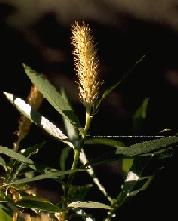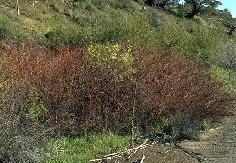

Copyright © 1995 Brother Eric Vogel, St. Mary's College
Caudata Willow
Salix lucida
ssp. caudata Nutt.
A woody, rather large decidious shrub with simple, alternate leaves and dense spikes (catkins) of unisexual flowers. The ovary develops inot a capsule that splits open at maturity, releasing hundreds of minute seeds with cottony appendages that catch the wind, allowing wide seed dispersal. The plant prefers light (sandy), medium (loamy) and heavy (clay) soils and can grow in heavy clay and nutritionally poor soils. The plant prefers acid and neutral soils. It cannot grow in the shade. It requires moist or wet soil. The plant can tolerates strong winds but not maritime exposure. Found in area of forests at elevations between 6000 and 8500 feet and usually under natural wet conditions.
Medicinal Uses:
The bark is analgesic, antiasthmatic, astringent and
haemostatic. It is used in the treatment of bleeding and asthma. A poultice of
the bark has been applied to the head to allay the pain of headaches. The
poultice has also been used to treat sores and bleeding cuts. An infusion of the
leaves is used as an analgesic in the treatment of headaches. The fresh bark
contains salicin, which probably decomposes into salicylic acid (closely related
to aspirin) in the human body. This is used as an anodyne and febrifuge.
